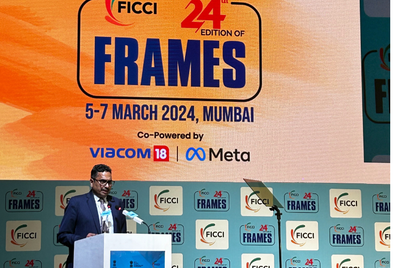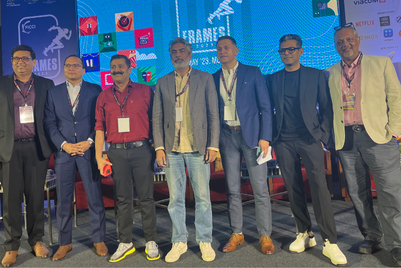
The annual FICCI Frames event, a much-anticipated yearly international forum for the Indian film industry, commenced on 5 March under the coordination of the Federation of Indian Chambers of Commerce & Industry (FICCI).
The overarching theme for this year is '#Reinvent'. Over the next three days, media and entertainment experts will illuminate the growth potential and innovations in OTT, cinema, and broadcast through panel sessions, keynote speeches, and masterclasses. The discussions highlight the dynamic nature of the media industry in India, with panelists emphasising the importance of innovation, audience engagement, and adaptability.
Campaign India takes you behind the scenes of the first day of this year's forum.
1. Inaugural session with Sanjay Jaju, secretary, Department of Defence Production, Ministry of Information & Broadcasting, Government of India
During the inaugural session of FICCI Frames, Sanjay Jaju, Secretary of the Ministry of Information & Broadcasting, Government of India, delivered a keynote address on India's OTT sector's transformative potential.
Jaju highlighted India's digital transformation, citing the surge in internet users and smartphones, making online media content more accessible. He emphasised the exponential growth of India's media and entertainment sector, with the digital media segment witnessing a 30% increase.
Jaju also examined the OTT revolution, noting the sector's projected half-billion-dollar industry status, as well as the proliferation of regional language platforms. He outlined government initiatives, including policy reforms like amendments to the Cinematograph Act and enhanced FDI limits, aimed at supporting sectoral growth.
Jaju also emphasised the Indian media industry's role in global competitiveness and soft power projection, advocating for initiatives to position India as a cinematic powerhouse. He stressed collaborative innovation, urging the sector to leverage digital technologies including AI to drive growth. Jaju's address set a visionary agenda for the industry, emphasising collaboration, innovation, and digital transformation as key drivers. As stakeholders convene to chart the industry's future, Jaju's insights provide a roadmap for transformative change and impactful contributions to India's socio-economic fabric.
2. Panel on growth projections across digital, content consumption and OOH

Moderator Ashish Pherwani (partner at Ernst and Young) set the context for the panel, emphasising the remarkable growth and diversity within the media sector. He highlighted key findings from the latest FICCI report, indicating substantial growth projections across various segments, including digital, gaming, and out-of-home advertising.
The key insights shared from the panel included:
Sandhya Devanathan, co-chair, FICCI Media and Entertainment committee, and vice president and head, Meta India
Devanathan underscored the significance of sports content in driving engagement and advertiser value, especially with the expansive reach of cricket across India. She discussed the shift towards placing sports content behind paywalls and the evolving landscape of mass production, stressing on the importance of tailored content for diverse audiences.
"Sports, particularly cricket, remains a powerful driver of content consumption on Reels, with advertisers valuing its wide reach. Embracing digital platforms and understanding consumer preferences are vital for sustained growth in the media industry. To enhance these experiences, Meta is investing significantly in AI to enhance user experiences and advertiser returns. The rise of short-form content, social media, and messaging presents new opportunities for engaging with audiences," shared Devanathan.
Arjun Nohwar, co-chair, FICCI media and Entertainment committee, senior vice president and general manager—India & South Asia, Warner Bros
"Content syndication and partnerships with distribution platforms are crucial for expanding reach and gaining insights into audience behavior. Embracing user-generated content is a new avenue for engagement," voiced Nohwar.
Nohwar also reiterated the importance of changing consumer preferences and innovating content delivery methods. He voiced the emergence of bite-sized, snackable content tailored for various consumption moments as a priority, also highlighting the need for engaging formats across platforms.
Sushant Sreeram, country head, Amazon Prime Video
Sreeram examined the dominance of video streaming as a use case for the internet, particularly outside metropolitan areas. He underlined the importance of catering to diverse customer segments and outlined Amazon Prime Video's strategy to offer a range of subscription and ad-supported services to meet varying consumer needs.
"Video streaming has become a dominant use case for the internet, especially outside metro areas for Prime. Our focus remains on delivering value, selection, and convenience to customers across various subscription models. Investments in technology, storytelling, and partnerships are essential for creating a vibrant entertainment ecosystem. Data-driven insights and collaboration with creators drive customer engagement."
Shripad Ashtekar, chairman and managing director, Signpost India
Ashtekar examined the role of out-of-home advertising (OOH) in enhancing urban spaces and providing value to commuters. He highlighted the potential for growth in the digital out-of-home segment, driven by innovations such as QR code technology and image analytics.
Gaurav Dwivedi, chief executive officer, Prasar Bharati
Dwivedi reflected on the enduring relevance of traditional media platforms, particularly set-top boxes, amidst the rise of digital streaming. He projected continued growth in set-top box penetration and underscored the importance of free-to-air television in reaching diverse audiences.
He shared, "Set-top boxes continue to play a significant role in content distribution, complementing the growth of digital platforms. The survival of various media forms underscores the enduring appeal of video content. The evolving media landscape offers opportunities for audio content, podcasts, and diverse storytelling formats. The key is to adapt to changing consumer preferences and embrace innovation."
Kevin Vaz, chair, FICCI media and entertainment committee, and Chief Executive Officer— Broadcast Entertainment, Viacom 18
Vaz put the spotlight on the agnostic approach of media companies towards content delivery, focusing on creating compelling content across various screens. He discussed the importance of understanding consumer preferences and adapting content strategies to suit different platforms, citing examples from reality shows and special events.
"As a content company, our focus is on creating engaging content tailored to different platforms and screens. Understanding consumer behaviour through data analytics is essential for content creation and distribution. The convergence of traditional and digital platforms presents new avenues for content consumption. Cross-platform content delivery and strategic partnerships enhance audience engagement and drive growth," Vaz highlighted.
3. Panel on the future of content creation and consumption

Moderated by Raghav Anand, partner at Ernst and Young. The panel comprised Ferzad Palia, business head for JioCinema Saugata Mukherjee, head of content for Sony LIV, Sony Pictures Network India, Rabindra Narayan, managing director and president for the PTC Network, Vishnu Mohta, co-founder of Hoichoi TV, and Darshan M, chief executive officer for Pressman Advertising.
Anand set the stage by highlighting the paradigm shift in media consumption, stressing the emergence of a borderless ecosystem. He accentuated the exponential growth of connected TVs and the diversification of programming segments, including gaming and user-generated content.
Explosion of content creation
Palia highlighted India's potential for 120 million connected TVs in 18 to 24 months, driven by Jio Air Fiber's growth. With digital payments, broadband, and connected devices, the subscription model sees vast opportunities according to Palia. He voiced, "Positive industry strides, including content cost rationalisation, may lead to a significant increase in subscriber household penetration for CTV in the next 18 to 24 months."
"The explosion of content creators has transformed the industry, with platforms now offering a multitude of choices to viewers. We're witnessing a move towards sustainable content models, with an increasing focus on quality," he added.
Consumer-centric approach
Saugata Mukherjee underscored the importance of a consumer-focused approach, citing the increasing demand for personalised content. He discussed the co-existence of hyper-personalised content and communal viewing experiences, driven by the proliferation of smart TVs and broadband connectivity.
"Platforms are embracing a consumer-centric approach, offering content tailored to diverse audiences. To adhere to this consumer trend, our job is to invest in pan-Indian content to cater to the evolving preferences of viewers," advised Mukherjee.
Crossing boundaries with content
Narayan shared insights on the global reach of Indian content, noting significant viewership and revenue from international markets. He highlighted the need for content to transcend regional boundaries and embrace diversity. Narayan also stressed on the importance of integrating virtual reality (VR) and artificial intelligence (AI) in content creation.
He expressed, "We're witnessing a revolution in cross-border content consumption, with technology driving innovation in delivery methods. AI-generated content and VR experiences are reshaping the industry."
The future of content personalisation
The panel concluded with Mohta predicting a future of hyper-personalised content, driven by AI and user preferences. He emphasised the democratisation of content creation, with creators gaining prominence in shaping programming choices. Mohta also examined the potential of AI-generated content and real-time advertising.
Sharing a take home point of view, Mohta concluded saying, "User-generated content is dominating the media landscape, prompting a shift towards personalised content delivery. AI-driven personalisation is the future of content creation."



.jpg&h=334&w=500&q=100&v=20250320&c=1)

.jpg&h=334&w=500&q=100&v=20250320&c=1)

.jpg&h=334&w=500&q=100&v=20250320&c=1)



.jpg&h=334&w=500&q=100&v=20250320&c=1)
.jpg&h=334&w=500&q=100&v=20250320&c=1)

.jpg&h=268&w=401&q=100&v=20250320&c=1)


.jpg&h=268&w=401&q=100&v=20250320&c=1)
.jpg&h=268&w=401&q=100&v=20250320&c=1)


